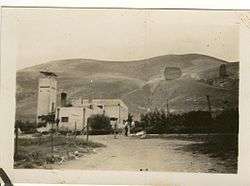Please tell us which country and city you'd like to see the weather in.

Beit Alfa
Beit Alfa (Hebrew: בֵּית אַלְפָא) (also Beit Alpha) is a kibbutz in the Northern District of Israel. Located near the Gilboa ridge, it falls under the jurisdiction of Gilboa Regional Council. The kibbutz as well as the archaeological site nearby containing the remains of an ancient synagogue, got their name from the Arab village that once stood here, Khirbet Bait Ilfa. In 2014 its population was 969.
Location
The kibbutz is located on the eastern edge of the Harod Valley, which lies between the Jezreel Valley and the Beth She'an Valley in the Lower Galilee. To the south and west are the steep slopes of the Gilboa mountain range. The closest peaks are Har Barkan (497 m) and Har Gefet (318 m). The area north and east of the kibbutz is flat, but falls to the east towards the Jordan Rift Valley. To the north of the kibbutz flows the Harod stream, whose waters are used to fill numerous ponds. 2.5 km southwest of the kibbutz runs the security fence separating Israeli territory from the Palestinian Authority. In its vicinity are the kibbutzim Heftziba, Sde Nahum, Nir David and Ma'ale Gilboa. On the Palestinian side is the village of Faqqua.

Beth Alpha
Beth Alpha or Bet Alpha or Bet Alfa is a sixth-century synagogue located at the foot of the northern slopes of the Gilboa mountains near Beit She'an, Israel. It is now part of Bet Alfa Synagogue National Park and managed by the Israel Nature and Parks Authority.
Excavations
The Beth Alpha synagogue was uncovered in 1928 by members of the nearby Kibbutz Hefzibah, who stumbled upon the synagogue’s extensive mosaic floors during irrigation construction. Excavations began in 1929 under the auspices of the Hebrew University of Jerusalem and were led by Israeli archaeologist, Eleazar Sukenik. A secondary round of excavations, sponsored by the Israel Antiquities Authority in 1962, further explored the residential structures surrounding the synagogue.
In addition, a hoard of 36 Byzantine coins were found in a shallow depression in the floor apse.
Architecture
Architectural remains from the Beth Alpha synagogue indicate that the synagogue once stood as two-story basilical building and contained a courtyard, vestibule, and prayer hall. The first floor of the prayer hall consisted of a central nave measuring 5.4 meters wide, the apse, which served as the resting place for the Torah Ark, the bema, the raised platform upon which the Torah would have been read, and benches. The Torah Ark within the apse was aligned southwest, in the direction of Jerusalem.
Radio Stations - Bet Alfa
SEARCH FOR RADIOS
Podcasts:

